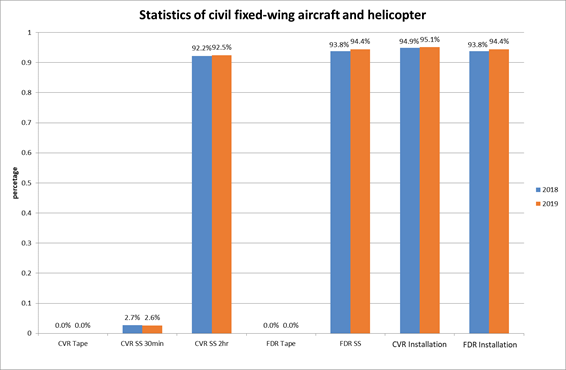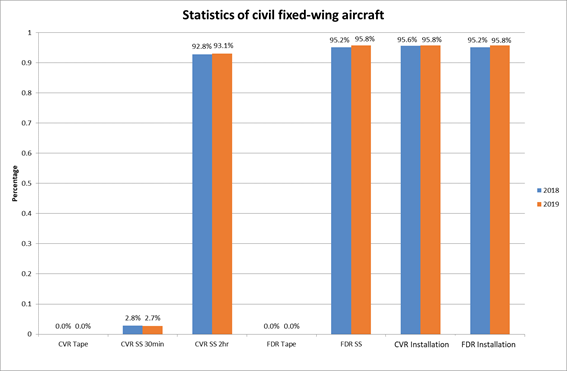2019 Flight Recorder Installation Survey Report
2019 Flight Recorder Installation Survey on National-Registered Civil and Public Aircraft
Date: 2019/08/21
- Background Introduction
Taiwan Transportation Safety Board (TTSB) carries out routine flight recorder installation survey on national-registered civil and public aircraft. Every year official document of flight recorder installation survey forms are sent to operators and government agencies. The goal of this survey is to find out the aircraft installation of cockpit voice recorder (CVR), flight data recorder (FDR), flight data acquisition unit (FDAU), quick access recorder (QAR), and lightweight flight recorder (LWR) at various national-registered operators. The findings would be the reference for the establishment of investigation laboratory’s flight recorder readout capability, so as to enhance the readout efficiency during the occurrence investigations.
The international specifications for flight recorders are derived from relevant Standards and Recommended Practices under Chapter 6 of the International Civil Aviation Organization (ICAO) Annex 6, and were referred by the Taiwan Civil Aviation Regulations 07-02A to require civil aviation operators in Taiwan should install flight recorders on board the aircraft. Taiwan Civil Aviation Regulations 07-02A were updated on 10th July 2019. The updated regulations are as follows:
1.NO.1-1A: The Requirements of Flight Recorders for Civil Air Transport Operations
2.NO.1-2A: The Requirements of Flight Recorders for General Aviation and Supplemental Operations
- No.2: The Requirements of Head Up Display (HUD) or Enhanced Vision System (EVS) for Civil Air Transport and General Aviation Operations
- No.3: Helicopter Performance and Operating Limitations
ICAO Annex 6 regulations on installation of flight recorders depend on aircraft category (fixed-wing or helicopter), operation type (commercial air transport or general aviation), date the type certificate was issued, maximum take-off weight (MTOW), and propulsion type to distinguish the needs to install flight recorders and the specifications. However, the aircraft may be exempted from requirements if the MTOW of the aircraft does not reach the weight threshold, the manufacturer does not provide any technical service for modification, or the operators can not obtain STCs issued by Taiwan CAA, FAA, EASA or civil aviation authority from the original design country for technical modifications.
Public and military aircrafts which are not governed by civil aviation regulations do not have relevant legal sources for the installation of flight recorders. However, the newly acquired public helicopters (UH-60M) and second-generation fighters (F-16/M-2000/IDF) are equipped with military flight recorders.
- The specific works accomplished are:
- Survey the models and the manufacturers of flight recorders.
- Survey the format of the flight data readout database.
- Survey the models and the manufacturers of FDAU.
- Survey the installation of FOQA system.
- Statistics of the installation of flight recorders in civil aviation aircraft.
- Statistics of the installation of QAR in civil aviation aircraft.
- Statistics of the installation of flight recorders in public aircraft.
- Statistics of the installation of portable GPS devices and light weight recorders (LWR) in public aircraft and general aviation aircraft which are not installed flight recorders.
- Analysis of laboratory readout capability of the flight recorders.
- Findings
TTSB accomplished the annual flight recorder installation survey on 21th August, 2019. This survey included nineteen operators - China Airlines, EVA Airways, UNI Airways, Far Eastern Air Transport, Mandarin Airlines, Tigerair Taiwan, Starlux Airlines, Aerospace Industrial Development Corporation, Daily Air, Emerald Pacific Airlines, ROC Aviation Company, Great Wing Airline, Winair Jet, Executive Aviation Taiwan Corp., Avanti Aviation, APEX Flight Academy, TDA AIR, Skyrainbow Airlines and Lu-Shi Management Consultant Co. Ltd., three government agencies - National Airborne Service Corps., Civil Aeronautics Administration, Taitung County Government and one academy - Asia-Pacific Institute of Creativity.
According to the responses from all these agencies and except hot air balloons, there are a total of 284 aircraft including 260 fixed-wings and 24 helicopters. Out of these, 266 are civil aircraft (259 fixed-wings and 7 helicopters) and 18 are public aircraft (1 fixed-wing and 17 helicopters).
The results are classified as findings from statistics related to civil operators, findings from statistics related to civil helicopters and balloons installed with portable GPS and LWR, findings from statistics related to public aircraft installed with flight recorder and portable GPS, and findings from FOQA statistics related to civil operators as follows.
3.1 Findings from statistics related to civil operators:
- No civil aircraft still installs tape-based flight recorders;
- Figure 1 shows the statistics of civil fixed-wing aircraft and helicopters:
- The proportion of the civil aircraft with CVR and FDR installation are 95.1% and 94.4% respectively;
- The proportion of the civil aircraft that has 30-min solid-state CVR and 120-min solid-state CVR installed are 2.6% and 92.5% respectively.
- Figure 2 shows the statistics of civil fixed-wing aircraft:
- The proportion of the civil fixed-wing aircraft with CVR and FDR installation are 95.8% and 93.1% respectively;
- The proportion of the civil fixed-wing aircraft that has 30-min solid-state CVR and 120-min solid-state CVR installed are 2.7% and 93.1% respectively.
- The statistics of civil helicopters are as below:
- There are 7 civil helicopters, 5 of which are equipped with CVR, and 3 of which are equipped with FDR.
- The proportion of the civil helicopter installed with CVR and FDR are 71.4% and 42.9% respectively.
- The proportion of the civil fixed-wing aircraft with the FDR readout database in papers and electronic files are 44% and 78.4% respectively.
- The proportion of verified FDR readout database for civil fixed-wing aircraft is 93.4%.
- The proportion of the civil fixed-wing aircraft CVR and FDR equipped with underwater locator beacon (ULB) are 93.5% and 94.6%.
- By 20 Aug. 2019, the readout capability at TTSB LAB for the surveyed CVR and FDR has reached both 100%.

Figure 1 Statistics of civil fixed-wing aircraft and helicopter

Figure 2 Statistics of civil fixed-wing aircraft
3.2 Findings from statistics related to civil helicopters and balloons installed with portable GPS:
- There are 7 civil helicopters, none of them are equipped with a portable GPS. The proportion of installation is 0.0%.
- There are 18 registered balloons in Taiwan. The Taitung County Government owns seven, Skyrainbow Airlines owns seven, Lu-Shi Management Consultant Co. Ltd. owns three and Asia-Pacific Institute of Creativity owns one.
- Up to 20th 2019, the readout capability at TTSB LAB for the surveyed portable GPS is 100%.
3.3 Findings from statistics related to civil helicopters and public aircraft installed with LWR:
- There are 7 civil helicopters, two Bell 206B are equipped with LWR. The proportion of installation is 28.6%.
- National Airborne Service Corps have 9 AS365 helicopters, which are currently in process of having LRS installed.
- By 20th 2019, the readout capability at TTSB LAB for the surveyed LWR has reached 100%.
3.4 Findings from statistics related to public aircraft installed with portable GPS:
- There are 18 public aircraft, 9 of them are AS365 helicopters and one BEECH-200 aircraft, 5 of them are equipped with portable GPS, thus the proportion of GPS installation is 50.0%.
- By 20th 2019, the capabilities at TTSB LAB for the surveyed portable GPS installed on the public aircraft have reached 100%.
3.5 Findings from statistics related to public aircraft installed with flight recorder and:
- There are 18 public aircraft, 8 of them are UH-60M helicopters and equipped with mil-spec flight recorders, thus the proportion of flight recorder installation is 44.4%.
- By 20th 2019, the capabilities at TTSB LAB for the surveyed flight recorders installed on the public aircraft have reached 100%.
3.6 Findings from FOQA statistics related to civil operators:
As per “Aircraft Flight Operation Regulation - Article 9”, by Taiwan CAA:
From 1 January 2009, an operator shall establish and implement a safety management system acceptable to the CAA which, as a minimum:”.
- Identifies safety hazards;
- Ensures that remedial action necessary to maintain an acceptable level of safety is implemented;
- Provides continuing monitoring (auditing) and regular assessment of the safety level achieved; and
- Aims to make continuous improvement to the overall level of safety.
The safety management system as set out in the preceding paragraph shall clearly define lines of safety accountability throughout the operator’s organization, including a direct accountability for safety on the management level, and comply with attachment 1.
An operator of an aircraft of a maximum certificated take-off mass in excess of 27,000 kg shall establish and maintain a flight data analysis programme as part of the safety management system in paragraph 1 above.
The flight data analysis programme as set out in the preceding paragraph shall be non-punitive and contain adequate safeguards to protect the source(s) of the data.
Seven national-registered operators have set up monitoring systems for daily operation and total fleet size is 222 aircraft. There are 194 aircraft equipped with QAR, 20 aircraft (including A350 and B787) use WQAR instead of QAR, the remaining 8 aircraft have been adopted their FDR data to FOQA purpose. Statistics of FOQA systems using by national-registered operators are listed as table 1.
Table 1 Statistics of FOQA systems of domestic operators
|
Operator |
FOQA Maker |
FOQA System |
FDM |
Animation |
|---|---|---|---|---|
|
China Airlines |
Aerobytes |
Aerobytes FDM |
Y |
Y |
|
EVA Airways |
Aerobytes |
Aerobytes FDM |
Y |
Y |
|
Mandarin Airlines |
Aerobytes |
Aerobytes FDM |
Y |
Y |
|
UNI Airways |
Aerobytes |
Aerobytes FDM |
Y |
Y |
|
Far Eastern Air Transport |
Teledyne |
GRAF/ PERMIT/VISION |
Y |
N |
|
AirFASE |
Y |
Y |
||
|
Tigerair Taiwan |
Teledyne |
AirFASE |
Y |
Y |
|
Starlux Airlines |
Teledyne |
AirFASE |
Y |
Y |
- Conclusions
One of the goals the TTSB Investigation Laboratory trying to pursue is to reach 100% capability of flight recorder readout for national-registered civil and public aircraft. To accomplish this, the laboratory carries out national-registered aircraft flight recorder installation survey every year. In overall, tape-based CVR and FDR were completely phased out since 2015. With the recommendation regarding promotes use of 120 minutes CVR issued to the CAA, there were positive responses in this survey. The proportion of 120 minutes CVR installation continually increases from 92.8 % (2018) to 93.1 % (2019). The 30 days ULB “Underwater Locator Beacons” attached to CVR and FDR are replaced by 90 days ULB due to the new ICAO recommendations and European regulation. The proportion of installation of 90 days ULB on the surveyed recorders are 93.5% and 94.6%.
Due to old avionics and related regulation limitations, the helicopters maintained low recorder installation rate in the past. However, with the introduction of new aircraft into the fleet, the proportion of CVR installation is gradually increased from 29.63% (2017) to 54.2% (2018), in the meantime the proportion of FDR installation is gradually increased from 18.52% (2017) to 45.8% as well, following the introduction of new aircraft into the fleet the expecting installation is increasing. For those helicopters still not equipped with flight recorders, TTSB will keep encouraging operators and relevant organizations to evaluate LWR installation and flight data applications, so as to elevate the flight safety.
By 20th Aug. 2019, the readout capabilities at TTSB LAB for the surveyed CVR, FDR, portable GPS and LWR both in civil and public aircraft have all reached 100%.
- Future plans
- Keep establishing readout capability for damaged avionic devices and developing a dynamic database system to manage the aircraft flight parameters.
- Improving readout and analysis capability for new generation flight recorders, which equipped on A321neo, A350 and B787 jets
- Establish Asia-Pacific Region investigation meeting to keep build up the capacity of TTSB engineering analysis ability. Invited JTSB TSIB and nearby country together to hold the technical conference and practical training.
Designing TTSB investigators international training program for improve the flight data mining, dynamic image analysis, and big data applications in aviation.